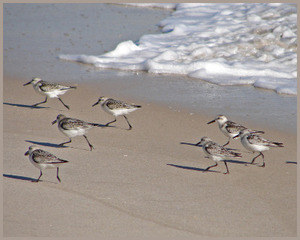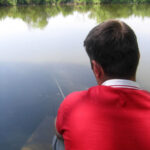Some of Massachusetts’s most fertile striped bass fishing grounds lie tucked away in shallows of the state’s sand flats, among them the flats at Duxbury Bay, off Chatham, and the flats on the western shores of Monomoy Island.
Here’s a look at one further north, near the Massachusetts/New Hampshire border, where Newburyport’s Joppa Flats at the tidal Merrimack River flatten towards Plum Island. The area is easy to access for anglers in small boats, and is typically productive during the fall and spring runs.
For schools of striped bass thick enough that recreational anglers quickly develop a case of striper thumb, the Joppa fishery lies just outside the tidal marshes which connect downtown Newburyport to the jumbled cheek-by-jowl overdevelopment of otherwise wildlife-refuge preserved Plum Island.
The flats extend along the western edges of the Merrimack River’s lower waters, east of the Custom House Maritime Museum and running southeast along Water Street to the Plum Island Turnpike, Woodbridge Island and Plumbush. Brushed by heavy deepwater tides that exit the river at Plum Island Point, Joppa is a good place for the beginning kayak angler, tin-skiffer or fly fisherman to try his hand.
At lower tides flats nearly triple in size, forming pools of water over sticky mud and mussel-beds. The flats are Massachusetts’ most northerly shallow-water fishing area, and the last estuarine waterway before the vast muddy wilds of tidal Great Bay, in New Hampshire.
Forming the ballooned pool at the mouth of the Merrimack River, the flats lie adjacent to estuarine marshes so vast they border or form the borders of eight towns south and west of the River.
To fish the flats by tin skiff, kayak or car top boat, take Water Street from downtown Newburyport to the small ramp on the left. Alternatively, if you have a sea kayak or a tin skiff, launch from the municipal ramp northwest of the route 1/1A bridge, off Merrimack Street. From either area you can slide in a tin skiff or kayak within two hours of low water. Alternatively, put in at the dirt ramp under the Plumbush bridge at the Plum Island River. If you have solid boat handing skills (the tide runs hard), you can also launch from the Cable Avenue boat ramp, at Salisbury Beach (where there’s camping available) just north of Newburyport Harbor Light (route 110 east, exit 58 from Route 95 to Salisbury/Route 1A east, then right (south) onto State Reservation Road.
Powerboaters can use Newburyport’s surfaced municipal ramp mentioned above (Route 113 east to Newburyport from exit 57 off Route 95.). From there you have the option of motoring a few short miles southeast to the flats or to the tidal rip at Plum Island Point. The flats run a couple miles from the waterfront area as far as Old Point Road, interrupted here and there by a small island or two. Though the flats can be fished at all tides, they tend to be most productive on rising and falling tides to three hours on either side of low, and at night.
Gear choices are basic: deeper trolling gear for the ridges where the flats slide off into deeper water; kastmasters, shads, and other light spincast gear on the flats and shallows.
Although Newburyport and the Merrimack River are part of the massive Plum Island Sound and Parker River marsh areas, they lack the Sound’s and nearby wildlife management areas’ serpentine channels, dead ends and leads which take you through all points of the compass. Navigation is pretty simple here.
The Joppa Flats, roughly an hour north of Boston, on route 95, pretty much begin on the fringe of downtown Newburyport and extend eastward to the dredged channel at Plum Island. Fed, raked, uncovered, and re-flooded continuously by the powerful Merrimack River, Joppa’s flats draw stripers in from the ocean to feed. Anglers can expect sustained schoolie breaks here from early spring onward. This is a highly productive area, with 30 or more hookups of fish under 30 inches not uncommon: a catch-and-release heaven. On the other hand, because the flats lie adjacent to the Merrimack’s dredged channels, linesiders over 30 inches can be taken from the deeper channel waters.
Joppa has four access points, all within ten minutes of downtown. The first is a small gravel parking lot, on the right, just below Plum Island bridge. Another, a small asphalt ramp with space for a half-dozen cars, lies off south Water Street. The third, a sandy carry-in for tin skiffs and kayaks, lies behind Surfland Bait and Tackle near Newburyport Harbor Light at the northern end of Plum Island. The fourth, off Merrimack Street west of the Route 1A bridge, has a surfaced ramp appropriate for trailers.
As with Duxbury Bay, Chatham, and Monomoy Island, gear choices here depend on water depth. In the shin-deep waters of the mussel beds, try light spincast gear on breaking schools or on the swirls of larger fish feeding close to the surface. In the river’s deeper waters, use deeper-sinking trolling gear.
Two caveats for Joppa: the river’s waters run swift. They jet into the open Atlantic from a narrow chute squeezed between two ripraps. This is dangerous territory for a tin-skiffer or kayaker. Also, because the mudflats and mussel beds are soft, fishing on foot here is a sink-to-your knees proposition. Best to stay in the boat and eschew sightfishing on foot.


